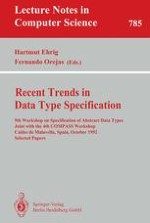1994 | Buch
Recent Trends in Data Type Specification
9th Workshop on Specification of Abstract Data Types Joint with the 4th COMPASS Workshop Caldes de Malavella, Spain, October 26–30, 1992 Selected Papers
herausgegeben von: Hartmut Ehrig, Fernando Orejas
Verlag: Springer Berlin Heidelberg
Buchreihe : Lecture Notes in Computer Science
Enthalten in: Professional Book Archive
